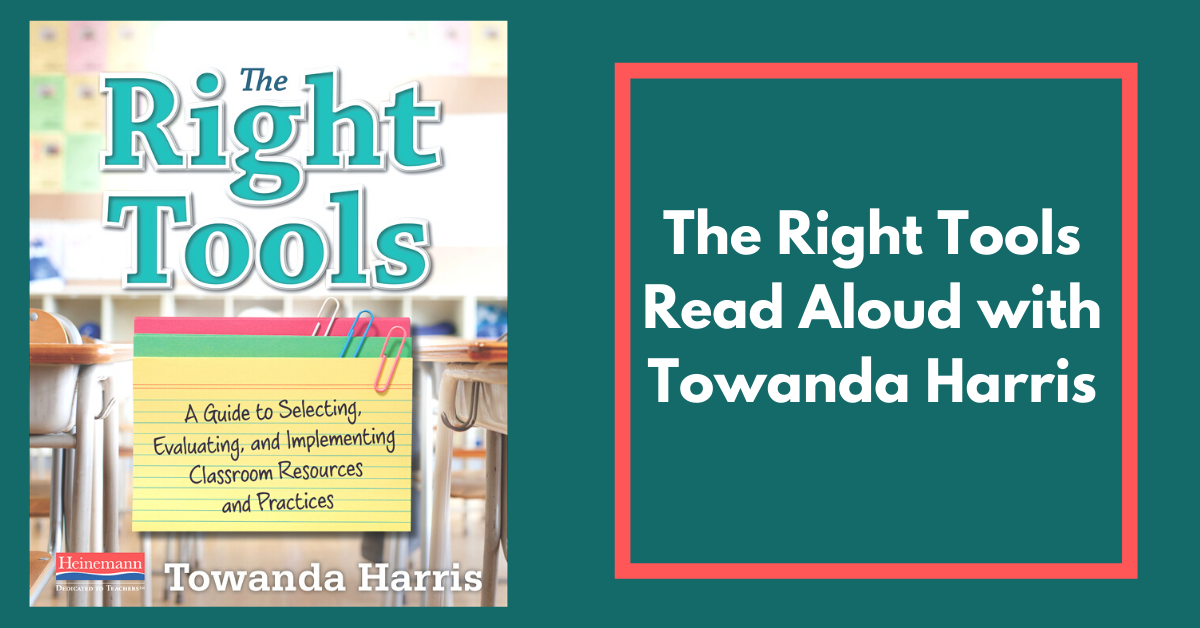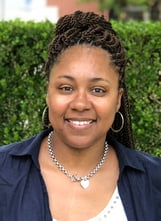 Today on the podcast we’re excited to bring you a special read aloud episode from Towanda Harris, author of The Right Tools: A Guide to Selecting, Evaluating, and Implementing Classroom Resources and Practices. Her book is all about focusing on your students and their needs and working from there to determine what resources are right for them.
Today on the podcast we’re excited to bring you a special read aloud episode from Towanda Harris, author of The Right Tools: A Guide to Selecting, Evaluating, and Implementing Classroom Resources and Practices. Her book is all about focusing on your students and their needs and working from there to determine what resources are right for them.
Towanda’s work reminds us that we do not need to be experts in the latest app, technology, or resource to be effective teachers. What we do need to be experts in, is knowing our students. This reminder to strategically focus on our students could not come at a better time as teachers look for new tools to teach remotely.
Below is a full transcript of this episode. This transcript is machine generated.
When I was eight years old, I rearranged my entire basement into a classroom so that I could be the teacher. I had a chalkboard, a teacher desk, plenty of carbon paper, flashcards, old workbooks, and anything else that I could find that looked like it might belong in a classroom. During family visits, I managed to get my cousins to play along as students, even if they called me Miss Davis begrudgingly. In that room, with those tools, I was the teacher.
Perhaps this story sounds familiar to you. Many of us who are now educators once played games like these, and in my first years as a teacher, I continued to collect a lot of stuff. I would keep everything I could fit into my room year to year. I use the words resources and stuff interchangeably. I had been collecting without really evaluating what I was bringing into my classroom. At the time, I saw this as building a set of tools, but how helpful are those tools if we don't know what they can do, if they're good quality, or if they'll work for the task at hand?
As I look back on those days now, I can see just how different this idea of teaching is from the teaching I've seen make a positive difference for children. Effective teaching comes from closely attending to students' needs, being mindful of their strengths, and choosing and designing instruction that meets them where they are and moves them ahead.
Early in my teaching career, I had the privilege of learning this lesson from mentors and colleagues. Later, in my work as a coach and now on the district level, I can still see this pattern at work. Although resources have the potential to be a great help to us, having a room full of supplies doesn't make us teachers. Helping our students learn and grow does.
Today, we often find ourselves facing a dizzying array of materials and resources, whether they be a box of dusty skill cards handed down from a retiring teacher, a professional book passed on by a colleague, a unit plan saved from a previous year, a teacher's manual found in the back of a storage cabinet, a procedure recommended by a supervisor, a program required by a district, a book reviewed on a blog, a set of activities discussed on Twitter, a chart found on Pinterest, a unit downloaded from a website, or a strategy highlighted in a brochure or an email, but how do we know which of these will help the children in our classrooms? How do we find helpful new resources without squandering funding or instructional time, or maybe we find ourselves working with the same resources we've used for years following their guidance, yet watching students hit the same predictable frustration points? How can we make adjustments to resources to maximize our support for our students, or do we need new resources or approaches altogether?
Maybe we are working with resources that for whatever reason, have come to dictate what we do in the classroom even if they aren't meeting our students' needs. How can we take a step back from the resources suggested, plans and timelines and, instead, use the resource strategically to best support our students? How can we bring in supplemental resources to help our students? Resources are, of course, only a piece of our work alongside our knowledge of best practices, our understanding of our students, and our ability to work and learn from our own team and colleagues and mentors. Yet, each of these pieces can have powerful effects when we use a resource that's well-matched to our students and their academic goals. We can make strong progress, but a resource that is not a good fit can do damage by wasting time, stalling student progress, disengaging students, frustrating struggling readers, or boring advanced learners. This can feel like many options to weigh, but, in fact, the process becomes much simpler when we keep a tight focus on the most important factor in the classroom, our students' strengths and needs.
When we invest some time in getting to know these variables, it becomes easier to decide which resources and approaches to try and to see a clear path ahead. Here are five questions to keep in mind as you consider a resource, material, or approach for use in your classroom.
Question one, what are my students' strengths and needs? Think about the difference between going grocery shopping when you have a list and running into the store without a plan when you're already hungry. You're more likely to come home with what you need and only what you need when you've planned in advance. When you identify what you and your students need, you make your own shopping lists of what to look for in the resource you consider.
Question two, how good is it? Many resources can look impressive at first, but how well do they work for the students in your classroom? Consider the skills, the resources support, the options they offer you as a teacher, and the alignment of the resource with your goals for your students. Additionally, don't let labels like research-based sway your decision. Find out what research was used and how it was used.
Question three, how will I use it? Even if a resource comes with detailed instructions, it's still up to us, the educators who know our students best, to decide how to use it best for our students.
Question four, is it working for my students? You've piloted a new resource, but is it helping your students? Use checkpoint assessments and feedback to assess how the resource is working?
You might think that those are all the questions you need, but there's one more you shouldn't overlook. How do I collaborate to learn even more? No matter how well-prepared we are for our work, collaboration can help us to support our students even better. Your colleagues are one of the most powerful resources available to you as a teacher. The other teachers, specialists, coaches, and administrators who know our students can give us insight about them that we could not gain on our own. It can also strengthen the safety net for students who might otherwise fall through the cracks.
In my experience, time and time again, I've seen students respond positively when a teacher is intentional about what he or she places before them. Every opportunity that we have with our students is an opportunity to stretch their thinking. Providing strong resources and best practices aligned with what our students need from us fosters an environment for real learning in which students are doing the heavy lifting, because, as we know, when we do most of the talking, then we, not our students, do most of the learning. As the experts who are entrusted with our students' learning, we must be protective of the children in our care, always asking ourselves, "What's working? What's not working?"
…
Learn more about The Right Tools at Heinemann.com
 Follow us on Instagram @heinemannpub to stay up to date on the latest books, your favorite authors, and upcoming events!
Follow us on Instagram @heinemannpub to stay up to date on the latest books, your favorite authors, and upcoming events!
 From the classroom to the district, Towanda Harris has trained teachers throughout the state of Georgia. She brings almost 20 years of professional experience to each of her sessions. Her workshops are engaging and provide teachers with useful tools that allow them to reflect on their current practice. Originally an elementary school teacher, she has served as a literacy coach, adjunct professor, K–12 staff developer, and curriculum writer.
From the classroom to the district, Towanda Harris has trained teachers throughout the state of Georgia. She brings almost 20 years of professional experience to each of her sessions. Her workshops are engaging and provide teachers with useful tools that allow them to reflect on their current practice. Originally an elementary school teacher, she has served as a literacy coach, adjunct professor, K–12 staff developer, and curriculum writer.
Some of her presentations at state and local conferences include, “Welcome to Comprehensionville” (Georgia Reading First Conference 2007), “Change is Not a Four-Letter Word” (Teachers of Atlanta Conference 2017), and “Creating Superhero Writers” (GDOE Summer Literacy Institute 2018). In addition to writing and consulting, Towanda serves as an Instructional Leadership Coordinator for an urban school district in Atlanta, Georgia. She and her husband Aaron have two sons and one daughter.
You can find her online at HarrisInnovationConsulting.com
Follow her on Twitter @drtharris



